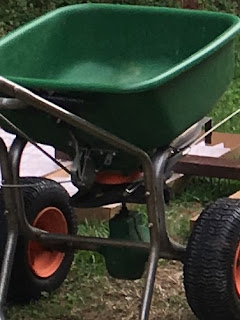This Spring was no exception, we had Matt Giese, from Syngenta come speak to our golf course maintenance staff, (we have three golf courses with 15 full time staff, 2 contract employees, and depending on the time of year, another 15 or so seasonal and part-timers). Matt had previously spoke to our superintendent chapter about calibrating sprayers. I checked with him to see if he could provide this same presentation to our staff, and he happily agreed to do that, along with helping us with spreader calibration.

Spreader calibrations we had already worked on the previous spring at my facility. We have Andersons, and Scotts spreaders, (for the youngsters in the business, Scotts many years ago had sold much of their professional turf and golf line to The Andersons, including their spreaders), and having a couple of different models posed some concerns for us when using the spreader settings on the bags for our starting points. So in 2018, we used the calibration tool that came with our Anderson's spreader and calibrated it and our two older R8-Scotts spreaders, (by the way, for some reason, the two spreaders the crew will grab first). After we used the calibration tool, we set up all three spreaders with the same amount of fertilizer, and each of us spread that out on our 60 x 80 turf plots next to the shop. All three put out the proper amount of fertilizer, so we knew they were adjusted properly.


What we really learned from Matt's presentation was fertilizer distribution. Is the fertilizer or product being distributed evenly across the area we are applying it over. Matt had as his tools for this part of the demonstration, was some rain gauges, and a fertilizer calibration tray system.

Scotts spreaders have a cone device under the hopper, to evenly distribute the fertilizer particles. They will provide the proper cone setting on their products, but when it comes to using other products, we tend to guess. I will usually check a similar Andersons product and go with their cone setting.
What we found out with the calibration testing, this cone setting doesn't always hold true. We were using another brand of 25-0-5, with an SGN of 205, we used their setting of M on the bag, and we usually will use a cone 6. After finding out that more product was distributed to the left of the spreader, we found a similar sized Andersons product with a cone setting of 4, that actually made the distribution pattern worse. We went the other way to a cone 8, which is usually reserved for 125 -150 SGN sized particles and we came out with a more even distribution pattern. Below on the left is the results of the first run, on the right, our third run. We also learned the effective width of our pattern. After we had concluded on our cone setting, Matt had measured out a test run, we weighed the material before putting it in the hopper, made our test pass, and then measured what was left in the hopper. We found out our speader was still calibrated properly when it came to putting out the proper amount of product.



The one part of sprayer calibration we wouldn't able to really show was the nozzle spray pattern because of the high winds of that day, (fertilizing calibration was done out of the wind behind our maintenance building. Matt has some test paper that would show the spray pattern, but we were unable to test that. We did make a test run on some asphalt and it showed a good pattern, with an even dry down on the pavement.
All in all, my staff enjoyed the presentation. Much thanks goes to Matt and Syngenta for supplying pitchers and rain gauges for measuring our products. We were reminded the importance of calibrating our equipment, and found that ours was still adjusted properly.











































